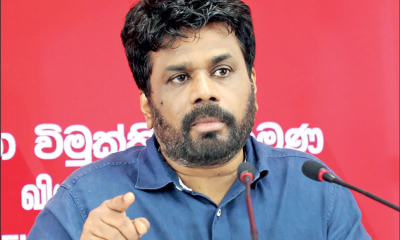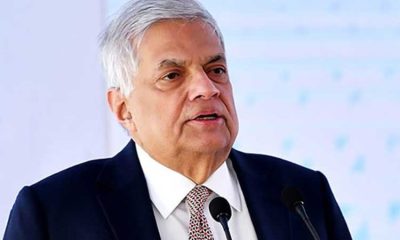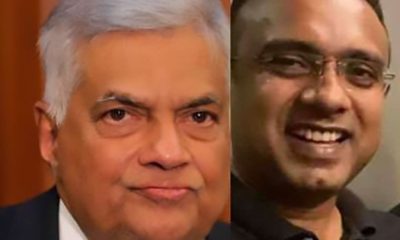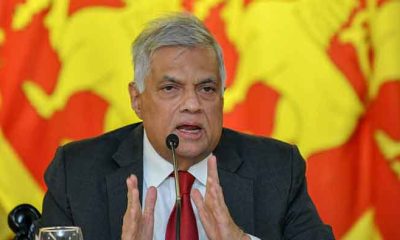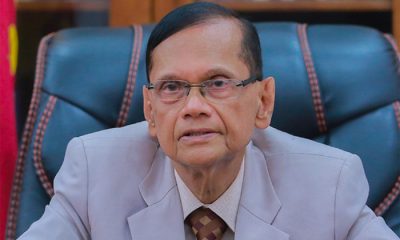Features
Israel & the US, Modi’s heatwave, and Ranil as Common Government Candidate
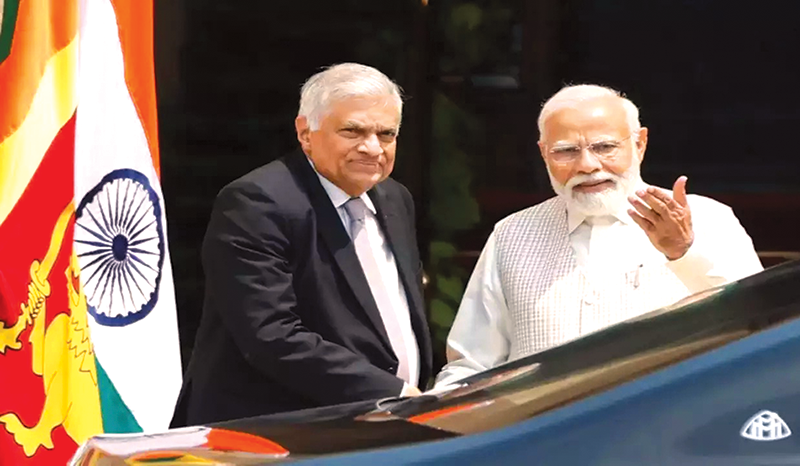
by Rajan Philips
To continue from where I left last week, the Middle East standoff between Iran and Israel has ended without further escalation. An “audible sigh of relief,” as BBC headlined it, swept through the region, and more so perhaps in Washington. Israel did have the last word by striking measuredly at Iran’s military installations in two Iranian cities and in south Syria. Iran ignored the strikes as inconsequential and “a defeat for the enemy.”
Lost in the attention to regional tension was the US vetoing of the UN Security Council resolution proposed by Algeria to grant Palestine full-member status at the UN, moving up from the permanent observer status it has had since 2012. The US diplomatic excuse was that a full membership status to Palestine should not be given through the UN process, but through “direct negotiations between the parties.” This reasoning is transparently illogical and also impractical given Mr. Netanyahu’s flat refusal of the two-state solution.
At the same time, the Biden Administration is trying to restrict Israeli military operations in Gaza and increase flow of aid and assistance to beleaguered Gazans now on the verge of famine. In addition, the Administration is also imposing sanctions against fundraisers for expanding Jewish settlements on the West Bank, and against Israeli military and police units for human violations of Palestinians in the settler areas. But that is not enough to stop Israeli forces from going ahead with ground assault in Rafah after two days of aerial pounding.
Washington appears to be taking a two-pronged approach to the crisis: provide diplomatic and political cover for Israel in international fora, and pushing for restraint on the military operations of the Netanyahu government. Perhaps a necessary approach not only to be effective in the Middle East but also to weather the political storms in the US. The latter is becoming the bigger political worry for Biden. America’s great universities are divided down the middle over the Israeli-Palestinian crisis. Republicans in the Congress are fomenting the fires in the name of fighting alleged antisemitism on campuses, even though a number of them are notoriously known for antisemitism in their politics.
On Wednesday, Republican House Speaker Mike Johnson travelled to New York to address a group of Jewish students on the steps of Columbia University library amidst heckling by pro-Palestinian protesters that included Muslims, Jews and other Americans. His mission: to call for the resignation of Columbia University President Minouche Shafik, an impeccably qualified Egyptian American woman. Democratic Congresswoman Ilhan Omar, a Somali American from Minnesota, joined the protesters at Columbia University, where her daughter is among the arrested demonstrators. In an official event in Syracuse protesters greeted President Biden with placards calling him “Genocide Joe”.
And on Thursday, the political and legal chaos surrounding Donald Trump reached a crescendo with simultaneous court proceedings in New York and at the Supreme Court in Washington. The apex court heard oral arguments on whether Trump is entitled to absolute presidential immunity, and peppered the lawyers for Trump and the government with penetrating questions. Judges in all lower courts have all decreed the obvious that there is no such immunity. The Supreme Court is expected to reject the claim of absolute immunity but its conservative majority could send the matter back to the lower courts to determine the facts in the case to which immunity would or would not apply. That would delay the trial and that is all that Trump is looking for now – in the hope that all his legal troubles could be ‘disappeared’ by winning the November election and allowing himself to a sweeping self-pardon dispensation.
Modi, Muslims and Maldives
The Indian election for the 18th Lok Sabha is now into its second week and second phase. Phase 1 voting was completed on Friday, April 19 in 102 Lok Sabha seats which included all 39 seats in Tamil Nadu. Phase 2 voting was on Friday this week covering 88 constituencies in 13 states. All of Kerala’s 20 seats are in Phase 2, which also includes voting for a portion of the seats in larger states like Bihar, Karnataka, Maharashtra, Madhya Pradesh, Rajasthan, Uttar Pradesh and West Bengal. Severe heatwave conditions are impacting voter turnouts in a number of states. But the biggest political heatwave was caused by Prime Minister Modi in an election campaign speech in Rajasthan.
Two days into the elections last Sunday, the Prime Minister threw away his usual dog whistle targeting Muslims and blew full into his foghorn of demagoguery – characterizing the commitment in the Congress Party manifesto to address wealth and income inequalities in society as a scheme to redistribute among Muslims the property and wealth of others. He even accused that Prime Minister Manmohan Singh had already started the scheme in 2006 and made Muslims the first claimants to the country’s resources. Then the punch line, as quoted in The Hindu: “That means the property will be distributed among those who have a large number of children… and among the intruders. Is it acceptable to you?”
Anyone other than Modi and his saffron followers would see the Congress manifesto as a response to increasing inequality during the last 10 years in spite of India’s overall economic growth. In 2006, the cerebral Manmohan Singh was addressing the structural problem of inequality and the purpose of public policy to uplift the impoverished – the subaltern castes, women and minorities including Muslims. But facts do not matter to Modi when it comes to Muslim bashing and he will do that not only during elections but any time between them as well. The hatred for Muslims might be part of Mr. Modi’s political DNA given his deep roots in the Rashtriya Swayamsevak Sangh (RSS), the onetime collaborator with colonial rule and the later progenitor of all right wing, anti-Muslim, and anti-Congress political formations in India.
The RSS will mark its birth centenary on September 27, 2025. Fittingly, the Sangh’s most accomplished son will be there as Prime Minister to preside over the occasion. Just as he was there to preside at the inauguration of the Ram Mandir in Ayodhya, Uttar Pradesh. But how fitting is it for India, the world’s largest democracy on course to become its third largest economy, to have a Prime Minister spewing hatred of Muslims when India is also the country with the worlds third largest Muslim population? Though unconnected, it was still fitting in a different way that days after Modi’s Muslim-hate speech in Rajasthan, the voters in Maldives voted resoundingly for the People’s National Congress (PNC) party of President Mohammad Muizzu who is known to be keen on steering Maldives away from India and closer to China. The PNC won 70 of 93 members in the national parliament, while the former ruling party, Maldivian Democratic Party (MDP), dubbed the ‘pro-India’ party, won just 12 seats.
Modi is not the most favourite Indian person in Maldives especially after his January visit to the beaches of the Indian islands of Lakshadweep, the oceanic neighbour of Maldives. His social media posts promoting Lakshadweep tourism were seen by Maldivians as crass and insensitive to the importance of tourism for the Maldivian economy. Although Modi’s hate speech was not a factor in the Maldivian election, it did not escape from being duly noted by Maldives politicians.
Politically, Modi balances his anti-Muslim diatribes with his Hindutva embrace of the multiple linguistic states and regions of India. To wit, his bottom-trawling efforts for votes in Tamil Nadu by resurrecting the controversy over Katchatheevu. In Kerala, however, where both Muslims and Christians are historically strong communities, the BJP is trying to set up the Christians against the Muslims. But the BJP is still the guest actor in Kerala where the battle is between the two front alliances led by the Congress and the Communist Party (CPM), even though outside Kerala the Congress and the CPM are part of the INDIA alliance. Rahul Gandhi himself is contesting from a seat in Kerala, Wayanad, after leaving Amethi, the family borough in Uttar Pradesh, under BJP pressure.
Ranil and Sunak
Modi’s brief resurrection of the Katchatheevu matter was all about embarrassing the DMK in Tamil Nadu and not at all about creating a row with Sri Lanka. Sri Lanka is now well wrapped up in Indian tentacles, and so it matters little on which side of the maritime boundary that Katchatheevu is located. The latest of them is the Ramayana Trail, the tracking of which was recently sponsored by the Indian High Commission in Colombo. The Sri Lankan search for Ravana’s helicopter may have ended with the exit of Gota, but looking for Ravana’s helicopter along the Ramayana trail could be a real booster to local tourism that apparently now permits the use of Indian Rupee as a designated tourist currency.
India is not the only one interested foreign party in Sri Lanka. The election season is apparently drawing special visitors from China, Japan, the US and the UK. The British election season is also likely to start soon as Prime Minister Rushi Sunak has indicated that the next election (due before January 28, 2025) will be held in 2024. It could come after Sri Lanka’s presidential election in September-October. There are interesting parallels between the situations of Ranil Wickremesinghe in Sri Lanka and Rush Sunak in Great Britain.
Both came into office as caretakers replacing predecessors who were forced to leave office. Both are viewed as good economic managers, although politically Mr. Wickremesinghe is a little too long in the tooth while Mr. Sunak is still a green Tory. Mr. Sunak’s Conservative Party has a good majority in parliament, but he has control over the party – whether in parliament or in the country. A committed Brexiteer, Mr. Sunak has had to bring in as his Foreign Minister, former Prime Minister David Cameron who quit over Brexit. Mr. Cameron definitely brings gravitas to foreign policy but has no national purchase. In short, unless there is a Labour earthquake, Mr. Sunak’s Prime Minister days are numbered.
Ranil Wickremesinghe’s stars and fortunes are different and might be even rising. He has no party in parliament but is in total control of parliament. He has no party to take to the hustings but that gives him the freedom to shop around for an alliance and promote himself as the common government candidate. A new political animal. The UNP-SLPP alliance is all but formalized for the presidential election. But they will keep their rallies separate for May Day. The rallies will be watched for their crowd size as a measure of political support and organizational resources. The election process itself would pick up pace after May Day next week.
Features
Democracy faces tougher challenges as political Right beefs-up presence

 It is becoming increasingly evident that the democracy-authoritarianism division would be a major polarity in international politics going forward. It shouldn’t come as a surprise if quite a few major states of both East and West gain increasing inspiration from the ‘world’s mightiest democracy’ under President Donald Trump from now on and flout the core principles of democratic governance with impunity.
It is becoming increasingly evident that the democracy-authoritarianism division would be a major polarity in international politics going forward. It shouldn’t come as a surprise if quite a few major states of both East and West gain increasing inspiration from the ‘world’s mightiest democracy’ under President Donald Trump from now on and flout the core principles of democratic governance with impunity.
It is the political Right that would gain most might in this evolving new scheme of things. Whether it be the US itself, France, Israel or Turkey, to name just a few countries in the news, it is plain to see that the Right is unleashing its power with hardly a thought for the harm being done to key democratic institutions and norms.
In fact, Donald Trump and his Republican hard liners led from the front, so to speak, in this process of unleashing the power of the Right in contemporary times. It remains a very vital piece of history that the Right in the US savaged democracy’s most valued institutions on January 6, 2021, when it ran amok with the tacit backing of Trump in the US Capitol.
What was being challenged by the mob most was the ‘will of the people’ which was manifest in the latter’s choice of Joe Biden as US President at the time. To date Trump does not accept that popular verdict and insists that the election in question was a flawed one. He does so in the face of enlightened pronouncements to the contrary.
The US Right’s protégé state, Israel, is well on course to doing grave harm to its democratic institutions, with the country’s judiciary being undermined most. To cite two recent examples to support this viewpoint, the Israeli parliament passed a law to empower the country’s election officials to appoint judges, while Prime Minister Netanyahu has installed the new head of the country’s prime security agency, disregarding in the process a Supreme Court decision to retain the former head.
Such decisions were made by the Netanyahu regime in the face of mounting protests by the people. While nothing new may be said if one takes the view that Israel’s democratic credentials have always left much to be desired, the downgrading of a democratic country’s judiciary is something to be sorely regretted by democratic opinion worldwide. After all, in most states, it is the judiciary that ends up serving the best interests of the people.
Meanwhile in France, the indications are that far Right leader Marine Le Pen would not be backing down in the face of a judicial verdict that pronounces her guilty of corruption that may prevent her from running for President in 2027. She is the most popular politician in France currently and it should not come as a surprise if she rallies further popular support for herself in street protests. Among other things, this will be proof of the growing popular appeal of the political Right. Considering that France has been a foremost democracy, this is not good news for democratic opinion.
However, some heart could be taken from current developments in the Gaza and Turkey where the people are challenging their respective dominant governing forces in street protests largely peacefully. In the Gaza anti-Hamas protests have broken out demanding of the group to step down from power, while in Turkey, President Erdogan’s decades-long iron-fist rule is being challenged by pro-democracy popular forces over the incarceration of his foremost political rival.
Right now, the Turkish state is in the process of quashing this revolt through a show of brute force. Essentially, in both situations the popular demand is for democracy and accountable governance and such aims are generally anathema in the ears of the political Right whose forte is repressive, dictatorial rule.
The onus is on the thriving democracies of the world to ensure that the Right anywhere is prevented from coming to power in the name of the core principles and values of democracy. Right now, it is the European Union that could fit into this role best and democratic opinion is obliged to rally behind the organization. Needless to say, peaceful and democratic methods should be deployed in this historic undertaking.
Although the UN is yet to play an effective role in the current international situation, stepped up efforts by it to speed up democratic development everywhere could yield some dividends. Empowerment of people is the goal to be basically achieved.
Interestingly, the Trump administration could be seen as being in league with the Putin regime in Russia at present. This is on account of the glaringly Right wing direction that the US is taking under Trump. In fact, the global balance of political forces has taken an ironic shift with the hitherto number one democracy collaborating with the Putin regime in the latter’s foreign policy pursuits that possess the potential of plunging Europe into another regional war.
President Trump promised to bring peace to the Ukraine within a day of returning to power but he currently is at risk of cutting a sorry figure on the world stage because Putin is far from collaborating with his plans regarding Ukraine. Putin is promising the US nothing and Ukraine is unlikely to step down from the position it has always held that its sovereignty, which has been harmed by the Putin regime, is not negotiable.
In fact, the China-Russia alliance could witness a firming-up in the days ahead. Speculation is intense that the US is contemplating a military strike on Iran, but it would face strong opposition from China and Russia in the event of such an adventurist course of action. This is on account of the possibility of China and Russia continuing to be firm in their position that Western designs in the Gulf region should be defeated. On the other hand, Iran could be expected to hit back strongly in a military confrontation with the US.
Considering that organizations such as the EU could be expected to be at cross-purposes with the US on the Ukraine and connected questions, the current world situation could not be seen as a replication of the conventional East-West polarity. The East, that is mainly China and Russia, is remaining united but not so the West. The latter has broadly fragmented into a democratic states versus authoritarian states bipolarity which could render the international situation increasingly unstable and volatile.
Features
Chikungunya Fever in Children

Chikungunya fever, a viral disease transmitted by mosquitoes, poses a significant health concern, particularly for children. It has been around in Sri Lanka sporadically, but there are reports of an increasing occurrence of it in more recent times. While often associated with debilitating joint pain in adults, its manifestations in children can present unique challenges. Understanding the nuances of this disease is crucial for effective management and prevention.
Chikungunya fever is caused by the chikungunya virus (CHIKV), an alphavirus transmitted to humans through the bites of infected Aedes aegypti and Aedes albopictus mosquitoes. These are the same mosquitoes that transmit dengue and Zika viruses, highlighting the overlapping risks in many areas of the world. It is entirely possible for chikungunya and dengue to co-circulate in the same area, leading to co-infections in individuals.
When a mosquito bites a person infected with CHIKV, it ingests the virus. After a period of growth and multiplication of the virus within the mosquito, the virus can be transmitted to another person through subsequent bites. Therefore, the mosquito acts as a vector or an intermediate transmitting agent that spreads the disease, but not as a reservoir of the disease. The spread of chikungunya is influenced by environmental factors that support mosquito breeding, such as stagnant water and warm climates. Urbanization and poor sanitation can exacerbate the problem by creating breeding grounds for these mosquitoes.
The clinical presentation of chikungunya in children can vary, ranging from mild to severe. While some infected children may even be asymptomatic and be normal for all intents and purposes, others can experience a range of symptoms, including a sudden onset of high fever, a common initial symptom. Pain in the joints of the body, while being a hallmark of chikungunya in adults, may be less pronounced in children. However, they can still experience significant discomfort and this must be kept in mind during processes of diagnosis and treatment. It is also important to remember that joint pains can present in various forms, as well as in different locations of the body. There is no characteristic pattern or sites of involvement of joints. Muscle aches and pains can accompany the fever and joint pain as well. A headache, too, could occur at any stage of the disease. Other symptoms may include nausea, vomiting, and fatigue as well.
A reddish elevated rash, referred to in medical jargon as a maculopapular rash, is frequently observed in children, sometimes more so than in adults. While chikungunya is known to cause such a rash, there is a specific characteristic related to nasal discoloration that is worth noting. It is called the “Chik sign” or “Brownie nose” and refers to an increased darkening of the skin, particularly on the nose. This discolouration just appears and is not associated with pain or itching. It can occur during or after the fever, and it can be a helpful clinical sign, especially in areas with limited diagnostic resources. While a generalised rash is a common symptom of chikungunya, a distinctive darkening of the skin on the nose is a particular characteristic that has been observed.
In some rare instances, particularly in infants and very young children, chikungunya can lead to neurological complications, such as involvement of the brain, known as encephalitis. This is associated with a change in the level of alertness, drowsiness, convulsions and weakness of limbs. Equally rarely, some studies indicate that children can experience bleeding tendencies and haemorrhagic manifestations more often than adults.
Diagnosis is typically made through evaluating the patient’s symptoms and medical history, as well as by special blood tests that can detect the presence of CHIKV antibodies (IgM and IgG) or the virus itself through PCR testing.
There is no specific antiviral treatment for chikungunya. Treatment focuses on relieving symptoms and allowing the body to recover on its own. Adequate rest is essential for recovery, and maintaining hydration is crucial, especially in children with fever. Paracetamol in the correct dosage can be used to reduce fever and pain. It is important to avoid aspirin, as it can increase the risk of a further complication known as Reye’s syndrome in children. In severe cases, hospitalisation and supportive care may be necessary.
While most children recover from chikungunya without any major issues, some may experience long-term sequelae. Joint pain can persist for months or even years in some individuals, impacting their quality of life. In rare cases, chikungunya can lead to chronic arthritis. Children that have suffered from neurological complications can have long term effects.
The ultimate outcome or prognosis for chikungunya in children is generally favourable. Most children recover fully within a few days or a couple of weeks. However, the duration and severity of symptoms can vary quite significantly.
Prevention is key to controlling the spread of chikungunya. Mosquito control is of paramount importance. These include eliminating stagnant water sources where mosquitoes breed, using mosquito repellents, wearing long-sleeved clothing and pants, using mosquito nets, especially for young children and installing protective screens on windows and doors. While a chikungunya vaccine is available, its current use is mainly for adults, especially those traveling to at risk areas. More research is being conducted for child vaccinations.
Chikungunya outbreaks can strain healthcare systems and have significant economic consequences. Public health initiatives aimed at mosquito control and disease surveillance are crucial for preventing and managing outbreaks.
Key considerations for children are that some of them, especially infants and young children, are more vulnerable to severe chikungunya complications and early diagnosis and supportive care are essential for minimising the risk of long-term sequelae. Preventing mosquito bites is the most effective way to protect children from chikungunya. By understanding the causation, clinical features, treatment, and prevention of chikungunya, parents, caregivers, and healthcare professionals can work together to protect children from this illness that could sometimes be quite debilitating.
 Dr B. J. C. Perera
Dr B. J. C. Perera
MBBS(Cey), DCH(Cey), DCH(Eng), MD(Paed), MRCP(UK), FRCP(Edin), FRCP(Lond), FRCPCH(UK), FSLCPaed, FCCP, Hony. FRCPCH(UK), Hony. FCGP(SL)
Specialist Consultant Paediatrician and Honorary Senior Fellow, Postgraduate Institute of Medicine, University of Colombo, Sri Lanka.
Joint Editor, Sri Lanka Journal of Child Health and Section Editor, Ceylon Medical Journal
Founder President, Sri Lanka College of Paediatricians – 1996-97)
Features
The Great and Little Traditions and Sri Lankan Historiography

Power, Culture, and Historical Memory:
(Continued from yesterday)
Newton Gunasinghe, a pioneering Sri Lankan sociologist and Marxist scholar, made significant contributions to the study of culture and class in Sri Lanka by incorporating the concepts of great and little traditions within an innovative Marxist framework. His theoretical synthesis offered historians a fresh perspective for evaluating the diversity of past narratives.
At the same time, Michel Foucault’s philosophical intervention significantly influenced the study of historical knowledge. In particular, two of his key concepts have had a profound impact on the discipline of history:
1. The relationship between knowledge and power – Knowledge is not merely an objective truth but a manifestation of the power structures of its time.
2. The necessity of considering the ‘other’ in any conceptual construction – Every idea or framework takes shape in relation to its opposite, highlighting the duality inherent in all intellectual constructs.
These concepts challenged historians to rethink their approaches, prompting them to explore the dynamic interplay between knowledge, power, and culture. The existence of Little Tradition prompted historians to pay attention to ‘other’ histories.
The resurgence of ethnic identities and conflicts has brought renewed attention to the dichotomy of culture, steering the discourse in a new direction. The ethnic resurgence raises three key issues. First, the way non-dominant cultures interpret the past often differs from the narratives produced by dominant cultures, prompting the question: What is historical truth? Second, it underscores the importance of studying the histories of cultural identities through their own perspectives. Finally, and most importantly, it invites reflection on the relationship between ‘Little Traditions’ and the ‘Great Tradition’—how do these ‘other’ histories connect to broader historical narratives?
When the heuristic construct of the cultural dichotomy is applied to historical inquiry, its analytical scope expands far beyond the boundaries of social anthropology. In turn, it broadens the horizons of historical research, producing three main effects:
1. It introduces a new dimension to historical inquiry by bringing marginalised histories to the forefront. In doing so, it directs the attention of professional historians to areas that have traditionally remained outside their scope.
2. It encourages historians to seek new categories of historical sources and adopt more innovative approaches to classifying historical evidence.
3. It compels historians to examine the margins in order to gain a deeper understanding of the center.
The rise of a new theoretical school known as Subaltern Studies in the 1980s provided a significant impetus to the study of history from the perspective of marginalised and oppressed groups—those who have traditionally been excluded from dominant historical narratives and are not linked to power and authority. This movement sought to challenge the Eurocentric and elitist frameworks that had long shaped the study of history, particularly in the context of colonial and postcolonial societies. The writings of historians such as Ranajit Guha and Eric Stokes played a pioneering role in opening up this intellectual path. Guha, in particular, critiqued the way history had been written from the perspective of elites—whether colonial rulers or indigenous upper classes—arguing that such narratives ignored the agency and voices of subaltern groups, such as peasants, laborers, and tribal communities.
Building upon this foundation, several postcolonial scholars further developed the critical examination of power, knowledge, and representation. In her seminal essay Can the Subaltern Speak?, Gayatri Chakravorty Spivak questioned whether marginalized voices—especially those of subaltern women—could truly be represented within dominant intellectual and cultural frameworks, or whether they were inevitably silenced by hegemonic. Another major theorist in this field, Homi Bhabha, also focused on the relationship between knowledge and social power relations. His analysis of identity formation under colonialism revealed the complexities of power dynamics and how they persist in postcolonial societies.
Together, these scholars significantly reshaped historical and cultural studies by emphasising the voices and experiences of those previously ignored in dominant narratives. Their work continues to influence contemporary debates on history, identity, and the politics of knowledge production.
The Sri Lankan historiography from very beginning consists of two distinct yet interrelated traditions: the Great Tradition and the Little Traditions. These traditions reflect different perspectives, sources, and modes of historical transmission that have influenced the way Sri Lanka’s past has been recorded and understood. The Great Tradition refers to the formal, written historiography primarily associated with elite, religious, and state-sponsored chronicles. The origins of the Great Tradition of historiography directly linked to the introduction of Buddhism to the island by a mission sent by Emperor Asoka of the Maurya dynasty of India in the third century B.C. The most significant sources in this tradition include the Mahāvaṃsa, Dīpavaṃsa, Cūḷavaṃsa, and other Buddhist chronicles that were written in Pali and Sanskrit. These works, often compiled by Buddhist monks, emphasise the island’s connection to Buddhism, the role of kingship, and the concept of Sri Lanka as a sacred land linked to the Buddha’s teachings. The Great Tradition was influenced by royal patronage and aimed to legitimise rulers by presenting them as protectors of Buddhism and the Sinhala people.
In contrast, the Little Tradition represents oral histories, folk narratives, and local accounts that were passed down through generations in vernacular languages such as Sinhala and Tamil. These traditions include village folklore, ballads, temple stories, and regional histories that were not necessarily written down but played a crucial role in shaping collective memory. While the Great Tradition often portrays a centralised, Sinhala-Buddhist perspective, the Little Tradition captures the diverse experiences of various communities, including Tamils, Muslims.
What about the history of those who are either unrepresented or only marginally represented in the Great Tradition? They, too, have their own interpretations of the past, independent of dominant narratives. Migration from the four corners of the world did not cease after the 3rd century BC—so what about the cultural traditions that emerged from these movements? Can we reduce these collective memories solely to the Sokari Nadagams?
The Great Traditions often celebrate the history of the ruling or majority ethnic group. However, Little Traditions play a crucial role in preserving the historical memory and distinct identities of marginalised communities, such as the Vedda and Rodiya peoples. Beyond caste history, Little Traditions also reflect the provincial histories and historical memories of peripheral communities. Examples include the Wanni Rajawaliya and the Kurunegala Visthraya. The historical narratives presented in these sources do not always align with those of the Great Tradition.
The growth of caste histories is a key example of Little Historical Traditions. Jana Wansaya remains an important source in this context. After the 12th century, many non-Goigama castes in Sri Lanka preserved their own oral historical traditions, which were later documented in written form. These caste-based histories are significant because they provide a localised, community-centered perspective on historical developments. Unlike the dominant narratives found in the Great Tradition, they capture the social, economic, and cultural transformations experienced by different caste groups. For instance, the Karava, Salagama, and Durava castes have distinct historical narratives that have been passed down through generations.
Ananda S. Kulasuriya traced this historical tradition back to the formal establishment of Buddhism, noting that it continued even after the decline of the Polonnaruwa Kingdom. He identified these records as “minor chronicles” and classified them into three categories: histories of the Sangha and Sasana, religious writings of historical interest, and secular historical works. According to him, the first category includes the Pujavaliya, the Katikavatas, the Nikaya Sangrahaya, and the Sangha Sarana. The second category comprises the Thupavamsa, Bodhi Vamsa, Anagatha Vamsa, Dalada Sirita, and Dhatu Vamsa, along with the two Sinhalese versions of the Pali Hatthavanagalla Vihara Vamsa, namely the Ehu Attanagalu Vamsa and the Saddharma Ratnakaraya. The third category consists of works that focus more on secular events than religious developments, primarily the Rajavaliya. Additionally, this category includes the Raja Ratnakaraya and several minor works such as the Sulu Rajavaliya, Vanni Rajavaliya, Alakesvara Yuddhaya, Sri Lanka Kadaim Pota, Kurunegala Vistaraya, Buddharajavaliya, Bamba Uppattiya, Sulu Pujavaliya, Matale Kadaim Pota, Kula Nitiya, and Janavamsaya (Kulasuriya, 1978:5). Except for a few mentioned in the third category, all other works are products of the Great Historical tradition.
Over the last few decades, Gananath Obeyesekera has traversed the four corners of Sri Lanka, recovering works of the Little Historical Traditions and making them accessible for historical inquiry, offering a new lens through which to reread Sri Lankan history. Obeyesekera’s efforts to recover the Little Historical Traditions remind us that history is never monolithic; rather, it is a contested space where power, culture, and memory continuously shape our understanding of the past. By bringing the Little Historical Traditions into the fold of Sri Lankan historiography, Obeyesekera challenges us to move beyond dominant narratives and embrace a more pluralistic understanding of the past. The recovery of these traditions is not just an act of historical inquiry but a reminder that power shapes what we remember—and what we forget. Sri Lankan history, like all histories, is a dialogue between great and little traditions and it is to engage both of them. His latest work, The Doomed King: A Requiem for Sri Vikrama Rajasinghe, is a true testament to his re-reading of Sri Lankan history.
BY GAMINI KEERAWELLA
-

 Sports5 days ago
Sports5 days agoSri Lanka’s eternal search for the elusive all-rounder
-

 News4 days ago
News4 days agoBid to include genocide allegation against Sri Lanka in Canada’s school curriculum thwarted
-

 News6 days ago
News6 days agoGnanasara Thera urged to reveal masterminds behind Easter Sunday terror attacks
-

 Sports19 hours ago
Sports19 hours agoTo play or not to play is Richmond’s decision
-

 Business7 days ago
Business7 days agoAIA Higher Education Scholarships Programme celebrating 30-year journey
-

 News5 days ago
News5 days agoComBank crowned Global Finance Best SME Bank in Sri Lanka for 3rd successive year
-

 Features5 days ago
Features5 days agoSanctions by The Unpunished
-

 Features5 days ago
Features5 days agoMore parliamentary giants I was privileged to know


